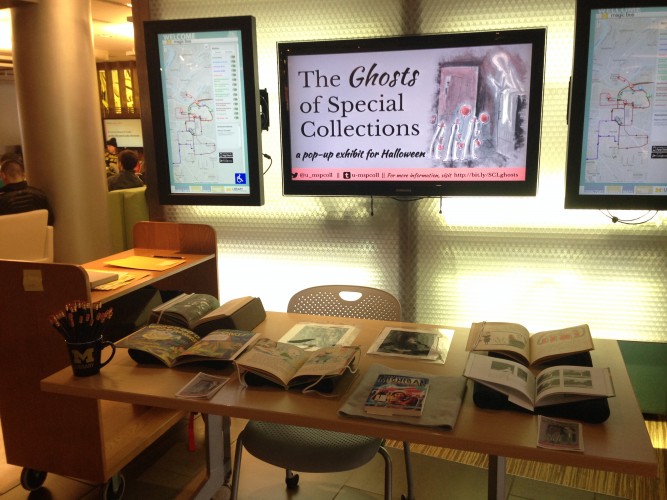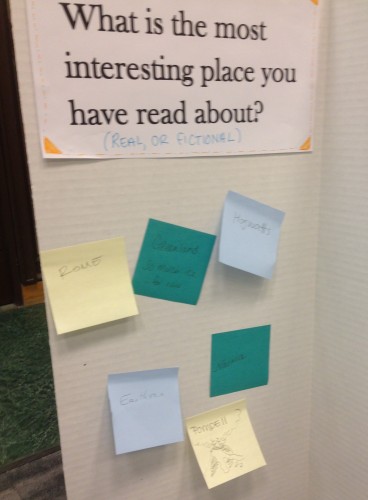Throughout the 2016-2017 school year, I've been immersed in a yearlong project experimenting with pop-up exhibits as a way for the Special Collections Library to reach more people in our community. Curator and Outreach Librarian Juli McLoone started this initiative last year. Juli mentored me extensively and gave me all the resources I needed to eventually take the lead on this work. Now that the project has wrapped up and my University Library Associate appointment is nearly complete, I'm excited to share some of what I've learned along the way.
A pop-up exhibit (or rare book meet and greet, as we later came to call them) is an informal, short-term display of Special Collections materials. We take our items outside of the Reading Room because we want as many people as possible to engage with our collections and ask our staff questions. We held six of these events in three locations within the Hatcher & Shapiro Libraries, and spoke with over 160 engaged visitors!

Ghost-related books and spirit photography on display for Halloween.
Each exhibit brought together a group of items related to a theme (for example, ghosts for Halloween in October), but what seemed to get our visitors most excited was the opportunity to interact with Special Collections materials hands-on, regardless of whether there was a timely or topical theme. I think, then, that the most important takeaway from this experience is how unique and meaningful this form of outreach can be.
Interacting with original materials hands-on through a pop-up exhibit is a very different experience than doing so online or in our Reading Room. Understanding the materiality of an item (what it's made of, how big it is, how fragile it might be, how it is decorated, etc.) can be a very important component of analyzing primary sources. Unlike online exhibits or collections of digitized materials, a pop-up exhibit environment allows visitors to consider the physicality of the items before them. Pedagogical value aside, getting to touch rare books is just plain cool. While visiting an item in our Reading Room allows hands-on engagement as well, visiting a pop-up exhibit lets folks avoid some of the less convenient Reading Room policies. Visitors in our Reading Room typically study one item at a time, but a pop-up exhibit usually brings together seven to nine items that can be viewed at the same time.
Perhaps the most significant benefit to this kind of outreach is the presence of Special Collections staff and access to the expertise they have to offer. As a relatively new staff member to U-M's Special Collections Library, planning and executing these exhibits helped me get to know the collections and provide better service to users who asked about them. Talking with a librarian at a pop-up exhibit is a great way for visitors to become acquainted with not only our collections, but also the services and learning opportunities we offer.

We experimented with different kinds of activities to get visitors engaged.
Finally, I've come to understand pop-up exhibits as a form of collaborative storytelling. Library staff can offer a narrative through the assemblage of items in an exhibit (for example, showing how attitudes and writing about dating have changed over time), but the questions and comments visitors bring also contribute to what's being presented. Comments and conversations add unique and personal contexts for visitors while helping staff understand what about a given set of materials may be most resonant for a specific audience. Each visitor who leaves a book open to a new page or participates in an exhibit-related activity is adding their own content and curatorial touch to the collection. This level of interaction means that an exhibit can look different for each visitor, and reflects the interests of our community as much as those of the staff who initially put the exhibit together.
To find out what exhibits and activities are on the horizon, look for updates (and sneak previews) on Twitter and Tumblr. And next time you pass by one of our exhibit tables, don't hesitate to stop and take a closer look.